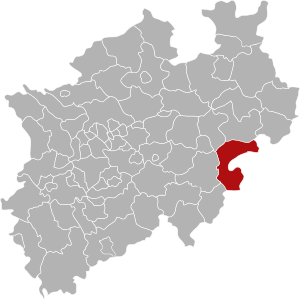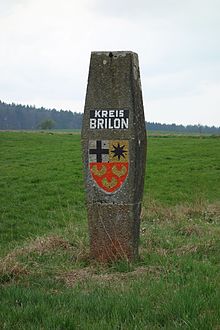Brilon district
| coat of arms | Germany map | |
|---|---|---|

|
Coordinates: 51 ° 23 ' N , 8 ° 34' E |
|
| Basic data (as of 1974) | ||
| Existing period: | 1817-1974 | |
| State : | North Rhine-Westphalia | |
| Administrative region : | Arnsberg | |
| Regional association : | Westphalia-Lippe | |
| Administrative headquarters : | Brilon | |
| Area : | 790.25 km 2 | |
| Residents: | 80,500 (Dec. 31, 1973) | |
| Population density : | 102 inhabitants per km 2 | |
| License plate : | BRI | |
| Circle key : | 05 8 33 | |
| Circle structure: | 63 municipalities | |
| Location of the Brilon district in North Rhine-Westphalia | ||
The district of Brilon was a district in the administrative district of Arnsberg that existed from 1817 to 1974 . With that he belonged first to the Prussian province of Westphalia , from 1946 finally to North Rhine-Westphalia . From 1939 to 1969 its name was Brilon County . The county seat was Brilon .
With effect from January 1, 1975, the district was dissolved and its area merged with that of the Arnsberg and Meschede districts to form the Hochsauerlandkreis .
geography
location
The district was in the northeastern Sauerland .
Neighboring areas
In 1973 the district bordered clockwise in the north, beginning with the Büren district (in North Rhine-Westphalia), the Waldeck and Frankenberg districts (both in Hesse ) and the Wittgenstein , Meschede and Lippstadt districts (all in North Rhine-Westphalia).
history
The district of Brilon was formed in 1817 in the administrative district of Arnsberg of the Prussian province of Westphalia from the old offices of Brilon and Marsberg of the Duchy of Westphalia . In 1819 the neighboring district of Medebach was dissolved, with the old Medebach office being added to the district of Brilon. In 1826/1827 the district was divided into the seven mayorships Bigge, Brilon, Hallenberg, Marsberg, Medebach, Thülen and Winterberg. Between 1837 and 1839 the town regulations of 1831 were introduced in Brilon, Winterberg, Hallenberg and Obermarsberg. As part of the introduction of the rural community order for the province of Westphalia, the mayor's offices were transferred to offices in 1844 .
In the district of Brilon there were initially four unofficial cities as well as six offices with two further cities, 58 municipalities and an estate district. In 1868 Hallenberg joined the Liesen office , which was renamed the Hallenberg office . In 1928 the municipalities of Oberalme and Niederalme were merged with the Alme estate to form the municipality of Alme.
In 1969 the municipalities of Bigge and Olsberg merged to form the city of Bigge-Olsberg .
On October 1, 1969, the district became the district of Brilon.
On January 1, 1975, the Brilon district finally merged into the newly founded Hochsauerlandkreis .
Population development
| year | Residents | source |
|---|---|---|
| 1819 | 29,082 | |
| 1832 | 31,819 | |
| 1871 | 38.105 | |
| 1880 | 37,866 | |
| 1890 | 38,415 | |
| 1900 | 39,640 | |
| 1910 | 42,462 | |
| 1925 | 47,068 | |
| 1939 | 50,726 | |
| 1950 | 73.011 | |
| 1960 | 72,600 | |
| 1970 | 78,400 | |
| 1973 | 80,500 |
politics
Results of the district elections from 1946
The list only shows parties and constituencies that received at least two percent of the votes in the respective election.
Share of votes of the parties in percent
| year | CDU | SPD | DZP | FDP | BHE |
|---|---|---|---|---|---|
| 1946 | 59.8 | 16.7 | 16.2 | 1.3 | |
| 1948 | 45.0 | 19.1 | 27.7 | 6.6 | |
| 1952 | 47.8 | 15.8 | 19.8 | 6.1 | 7.0 |
| 1956 | 53.1 | 19.7 | 16.7 | 5.1 | 5.3 |
| 1961 | 58.0 | 21.3 | 10.6 | 7.1 | 3.0 |
| 1964 | 57.9 | 25.5 | 9.3 | 6.4 | |
| 1969 | 57.7 | 26.7 | 9.6 | 4.6 |
District administrators
- 1817–1845 Maximilian Droste zu Vischering-Padberg
- 1846–1878 Caspar Maximilian Droste zu Vischering-Padberg
- 1879–1900 Hans Carl Federath
- 1900–1909 Johann von Gaugreben
- 1909–1936 Heinrich Jansen
- 1936–1945 Peter Schramm
- 1945–1946 Friedrich Brümmer
- 1946 Wilhelm Tewes , CDU
- 1946–1948 Josef Roggenkamp , center
- 1948–1949 Johann Quick , CDU
- 1949–1950 Wilhelm Stracke , center
- 1950–1952 Lorenz Hoffmann , CDU
- 1952–1969 Albert Günther , CDU
- 1969–1974 Bertram Biederbeck , CDU
- 1974 Rudolf Kraft , CDU
Upper District Directors
- Friedrich Brümmer (1946–1949)
- Robert Steineke (1950–1958)
- Adalbert Müllmann (1958–1974)
coat of arms

|
Blazon : Divided and split above by silver and gold; in front a continuous black cross, behind an eight-pointed black star, below three golden sea leaves in red. Description: The coat of arms consists of the emblem of the Elector of Cologne as a former sovereign and the star of the coat of arms of the Counts of Waldeck, who had individual sovereign rights here. The sea leaves symbolize the former affiliation to the Saxon tribe of Engern. The coat of arms was approved on October 18, 1951. |
Offices and municipalities
Unofficial cities
- Brilon
- Hallenberg (until 1868 or 1876)
- Obermarsberg
- Winterberg
Offices
-
Office Bigge
- Altenbüren
- Antfeld
- Assinghausen
- Bigge (until 1969)
- Bigge-Olsberg (town, since 1969)
- Bruchhausen
- Brunskappel
- Elleringhausen
- Elpe
- Esshoff
- Grimlinghausen
- Helmeringhausen
- Olsberg (until 1969)
- Siedlinghausen
- Wiemeringhausen
- Wulmeringhausen
-
Amt Liesen , since 1868 or 1876 Amt Hallenberg
- Braunshausen
- Hallenberg (town, since 1868 or 1876)
- Hesborn
- Liesen
- Züschen
- Office Medebach
- Niedermarsberg office
- Office of Niedersfeld
-
Office Thülen
- Alme (since 1928)
- Bontkirchen
- Hoppecke
- Madfeld
- Messinghausen
- Nehden
- Niederalme (until 1928)
- Oberalme (until 1928)
- Radlinghausen
- Rixen
- Rosenbeck
- Scharfenberg
- Thulen
- Hurled
- Alme Manor (until 1928)
License Plate
On July 1, 1956, the district was assigned the distinctive sign BRI with the introduction of the license plates that are still valid today . It was issued until December 31, 1974.
literature
- Statistical review for the district of Brilon, published by the State Statistical Office of North Rhine-Westphalia, Düsseldorf 1967.
- Become, grow, work. From the changing times. District administrations in the Hochsauerlandkreis from 1817 to 2007. Meschede 2007.
- Hugo Cramer: The district of Brilon in the Second World War 1939–1945 - reports from many employees from all over the district. Josefs-Druckerei, Bigge 1955.
- Josef Rüther: The district of Brilon ( district and city handbooks of the Westphalian Heimatbund , issue 14). Munster 1951.
Web links
Individual evidence
- ↑ a b Westfalenlexikon 1832–1835 . In: Landschaftsverband Westfalen-Lippe (Ed.): Reprints for the Westphalian archive maintenance . tape 3 . Münster 1978 (reprint of the original from 1834).
- ↑ Landgemeinde -ordnung for the Province of Westphalia from October 31, 1841 (PDF; 1.6 MB).
- ^ Official Journal for the Arnsberg District 1844, pp. 32, 62, 83, 148, 192. Accessed on February 2, 2014 .
- ↑ Announcement of the new version of the district regulations for the state of North Rhine-Westphalia from August 11, 1969 in the Law and Ordinance Gazette for the state of North Rhine-Westphalia, year 1969, No. 2021, p. 670 ff.
- ^ Federal Statistical Office (ed.): Historical municipality directory for the Federal Republic of Germany. Name, border and key number changes in municipalities, counties and administrative districts from May 27, 1970 to December 31, 1982 . W. Kohlhammer, Stuttgart / Mainz 1983, ISBN 3-17-003263-1 , p. 332 .
- ^ Statistisches Bureau zu Berlin (Ed.): Contributions to the statistics of the Prussian state . Duncker & Humblot, Berlin 1821 ( digitized version ).
- ↑ a b Community encyclopedia Westphalia 1887, p. 131
- ↑ a b c d e f g Michael Rademacher: German administrative history from the unification of the empire in 1871 to the reunification in 1990. brilon.html. (Online material for the dissertation, Osnabrück 2006).
- ↑ Statistical Yearbook for the Federal Republic of Germany 1972
- ↑ Statistical Yearbook for the Federal Republic of Germany 1975
- ↑ Source: respective issue of the State Statistical Office (LDS NRW), Mauerstr. 51, Düsseldorf, with the election results at the district level.
- ^ Eduard Belke, Alfred Bruns, Helmut Müller: Communal coats of arms of the Duchy of Westphalia. Arnsberg 1986, ISBN 3-87793-017-4 , p. 139.
- ↑ ngw.nl
- ↑ a b c There are contradicting information about the date of incorporation of the previously free city of Hallenberg into the Liesen office, which was then renamed the Hallenberg office . According to the Brilon district (ed.): The Hochsauerland yesterday - today - tomorrow. 150 years of the Brilon district. Brilon 1969, p. 23: "The current situation was reached in 1868, when Hallenberg could be reunited with the Liesen office and became the center of the office." According to www.territorial.de, Hallenberg office: "25.2.1876 ... incorporation of the rural community Hallenberg, City, in the office Liesen; Renaming of the Liesen office to Hallenberg ”.






